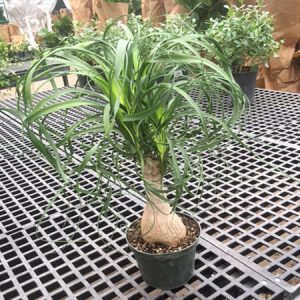Description
This wide ranging genus of more than 300 upright, rhizomatous, or bulbous perennial, with few evergreen species, is native to the temperate regions of the Northern Hemisphere, in named for the Greek goddess of rainbow and is valued for its beautiful and distinctive flowers. Each flower has 6 petals, 3 outer petals called ‘falls’, which droop away from the center and alternate with the inner petals called ‘Standards’. There are many hybrids. Most flower in spring or summer, ‘Bearded are remontant, flowering again in the same year. Irises are divided into 2 main groups, rhizomatous and bulbous.
Rhizomatous Irises have sword to linear shaped leaves, are sometimes evergreen, and are sub divided into 3 groups: bearded (or flag) irises, with a tuft of hairs (the ‘beard’) on the 3 lowers petals, beardless irises, without the tuft, crested or Evansia irises, with a raised crest in lieu of a bread.
The bearded types including the rare and beautiful Oncocyclus and Regelia irises, native to the Eastern Mediterranean and Central Asia and so needing cold winters and hot, dry summer to flourish. Hybrids between these 2 groups are called Regeliocyclus irises, while hybrids between either of then and other bearded irises are called Arilbred irises. But the main group of bearded irises consists of numerous species with thick, creeping rhizomes, mainly from temperate Eurasia, and countless hybrids bred from these: both species and hybrids can be subdivided into 3 classes. Tall bearded grows 27″ tall or more with flowers 4-8″ across, Intermediate bearded irises grow 16-27″ tall and has flowers 4-5″ across, and dwarf bearded irises growing 8″ tall and has flowers 1-3″ across, depending mainly on height of the plant but some other charteristics as well. Tall bearded irises are the most popular class of irises, with by far the largest number of hybrid cultivars.
The beardless (Limniris) irises are mostly plants with long narrow leaves and include several identifiable groups of species and hybrids most notably the Eastern Asian. Laevigatae or Water Irises include the large flowered ‘Kaempferi’ irises (a.k.a Japanese Irises) derived from I ensata, the Louisianna irises from Southeastern USA and their hybrids, the Pacific Coast Irises from the west side of North America, also with many hybrids, and the Eurasian Spuria and Siberian Irises, consisting of numerous species and a scattering of hybrids.
The bulbous irises bloom from late winter to mid summer are divided into 3 groups, the Juno (scorpiris), Recticulata (hermodactyloides) and Xiphium irises, the first 2 consisting of beautiful but mostly difficult bulbs from Western and Central Asia. The Xiphium irises, are centered on the Mediterranean and more easily grown, they have given rise to a group of bulbous hybrids including the so-called English, Spanish and Dutch irises, it is the latter that are commonly seen in florist shops.
All parts may cause severe discomfort if ingested, contact with sap may irritate skin.
Growing conditions, vary greatly, however, as a rule rhizomatous irises, with the exception of the crested or Evansia irises, are very frost hardy and prefer a sunny position, some of the beardless types like very moist soil. Bulbous irises are very frost hardy, and prefer a sunny position with ample moisture during growth, but very little during their summer dormancy, plant in fall at a depth at least twice the height of the bulb.
Prone to iiris borer, verbena bud moth, whiteflies, iris weevil, thrips, slugs and snails, aphids, nematode, bacterial leaf blight, soft rot, crown rot, rhizome rot, leaf spot, rust, viruses, ink spot fungus and scorch.
I. ‘Dress Circle’ – This spuria iris grows 36″ tall and flowers in mid and late season with standards are blue-violet, with white veins, falls have yellow patches surrounded by white and violet edging
Zones Vary





